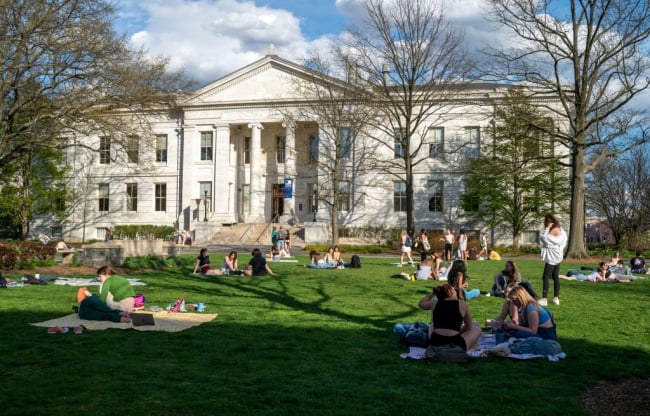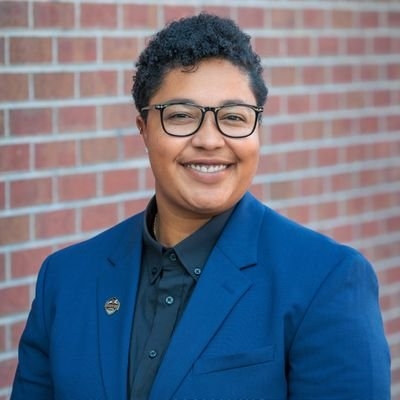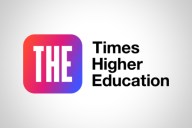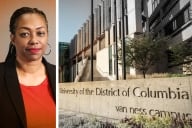You have /5 articles left.
Sign up for a free account or log in.

As the vice president for retention, thriving and student success at American University, Ashlie Prioleau is responsible for promoting student engagement and fun, among other retention strategies.
Robert Nickelsberg / Getty Images North America
Growing up, education was always a priority for Ashlie Prioleau. Her grandmother didn’t complete a college degree, and her mother earned a bachelor’s but couldn’t progress further because she was a single mother, driving Prioleau to be ambitious in her postsecondary education.

Ashlie Prioleau, assistant vice president for retention, thriving and student success at American University.
Ashlie Prioleau
After earning a bachelor’s degree in chemistry from Carnegie Mellon University and a master’s in higher education administration from the University of Pittsburgh, Prioleau launched a career in higher education looking to better serve minoritized students, like herself.
Now the assistant vice president of retention, thriving and student success at American University in Washington, D.C., Prioleau spoke with Inside Higher Ed about her career trajectory and the importance of thriving in student success.
Q: What is your role at AU and how does it fit into the institutional vision for student success?
A: First of all, this was my dream job. I have to say that I’ve always wanted a position like this, where I essentially serve as the bridge right between many different units on campus, many different offices. In fact, my role, actually, is to help build a solid coordinated care network across the university.
We have a lot of great programs. We have amazing people, both staff [and] faculty, as well as our students. Exceptional leadership, exceptional programs. But what’s bringing that all together? Who’s telling the narrative? Who’s also looking at the opportunities for collaboration?—and I mean strategic collaboration, not just, “Oh, you’re doing this, I’m doing that. Why don’t we somehow come together at some point?” But really, on the front end, to try to make sure that we’re having more strategic conversations.
In my role, I lead a group of over 50 campus leaders, and we call it the STAR team, Students Thriving And Retention, intentionally to try to get at the real goal.
We spend so much time talking about retention, graduation, but there is a world with our students like me, where, I retained at a school, but was I thriving? And in some ways, yes. But in others, not so much.
I think we need to reshift the conversation to talk a little bit more about student thriving, which is the reason why the order in the intentionality of these words matter: Student. Thriving. And Retention. And that group is intentionally designed to support students, staff and faculty—accessing the campus resources, looking at data, making sure we don’t have duplication, making sure that we have a solid action plan that we know we’re dividing and conquering. But we’re also coming back together to talk about what we’ve learned and the impact that we’ve made.
Q: Prior to this role, you worked as a consultant. What did you do in this position and how does that impact your view on higher education?
A: Actually, I started in consulting right after my master's program and as I entered into my doctoral work with AACRAO [American Association of Collegiate Registrars and Admissions Officers] and so that was my first taste.
I was more on the enrollment management side there, and I saw just another opportunity. We put in all this work, we invest money, we invest time, to get these students enrolled, and then what? We clearly saw with the data that a lot of students were not retaining; they were not making it to graduation. That shifted gears for me internally, but also professionally, to start thinking a little bit more about student success.
Then I pursued a career in consulting for five years at the Education Advisory Board (EAB), doing specific student-success consulting work, as well as technology assessments and implementations, which gave me a lot of skill sets to be able to then, ultimately, start my own business, Brown Bridges, where I do a lot of data analytics, infrastructure [and] build outs. I look at opportunity assessments for different schools and colleges—specifically public universities, as well as community colleges that don’t have a ton of resources—that have more students that have similar backgrounds to myself, that I know need it the most.
It’s a passion project of mine and it’s something that I continue to open doors for and have conversations [about]. It also helps me stay connected to all the great things that are happening in higher education and how to take that one step further to make our students the most successful they possibly can be.
Q: When we talk about institutional data, there is a lot of student data available, but piecing the narrative together and finding gaps can be a challenge. Where do you see your role as a data storyteller as well as an analyst?
A: When I start a presentation, I sometimes ask the crowd—and these are AU people—“Does anyone know what our retention rates are? Does anyone know what our graduation rates are?”
Sometimes it’s a mixed bag of responses and answers. You get everything from “We’re at 95 percent” to “60 percent.” So being able to start the story with where we are, and not just the numbers, but really starting to dig into the student personas that we have.
We have pulse surveys that go out to try to collect students’ feelings and sentiments about their experience to date. We’re doing that every semester now, so we’re not just going to stop at the, “OK, this is what our [retention and graduation] rates are.” But why? And to divide it between the students who are saying, “This is the reason why I’m staying. This is why I love American University.” And then on the other side is, “Well, this isn’t working out. I don’t think I fit here, I don’t have that sense of belonging that I see maybe other peers or students on campus having.”
We need to study both. And that’s really how I start to shape the narrative, the students who are potentially about to leave, or thinking about leaving, or have left versus the students that are staying and really taking advantage of all the great things that American University has to offer.
Q: Just in your initial time here, what have you found are those challenges for the student who doesn’t feel like they’re thriving at the institution?
A: I think it does come down to social connections. I think we skip over the importance of having fun. Even when I think back to my experience … when I think about the times that I was thriving, I was having the most fun in my entire life. And you can marry that with, you tell your kids those stories, you’re going to tell your grandkids those stories. That’s the goal, we want to make sure that we have that baked in through our school spirit, through our traditions, every at the time that they apply—even before that, if they come for a campus visit—all the way through the time that they graduate.
I can’t underscore that enough, because there are issues that we know happen on campuses. This isn’t specific to American, but sometimes the residence halls aren’t as nice as they would want it to be. Or sometimes this class is just so, so hard, it’s driving these students up the wall, trying to figure out how to pass it.
Regardless of the challenges that they face, if they can think to the times that they have fun, that they have a social circle, they have friends that they’re going to have for the rest of their lives, that makes it worth it. I really think what we’re uncovering, more than anything, is to make sure that students are enjoying their experience even when there are bumps in the road.
Q: What are some of your goals?
A: We have almost eight different projects that we are currently working on. They come together as part of that STAR team.
We are committed to making sure that our academic pathways are more transparent. And I really do mean, semester by semester: What courses do you need to take from a prospective student level perusing the website? Trying to get a sense of what you might be interested in and how that aligns with your future career ambitions but also to layer that on with experiential learning.
There’s been so many great people [at AU who] have put together a website that has all of our experiential learning opportunities and an inventory for students to choose from. But in order for them to navigate that, we want to layer that on with the academic pathways to help inform them on when to do what.
We also are working to map out the entire student lifecycle. Our focus previously has really been around the first-year experience and we noticed that … there is a drop that happens at that sophomore line. And so, trying to think about more strategic ways to scale our living-learning communities, to think about our residence life experience for sophomore students. But then also beyond: What are we doing also for juniors, seniors, and what we’re calling super seniors, those that are above 120 credits? Or perhaps those that, through COVID or other issues that might have happened, have had to take time away but now they’re back. How do we move them forward in a really quick fashion?
As part of that student-lifecycle work, we are piloting student-success coaching through my office, where we are … creating [individual] thrive plans for holistic student support, basically getting at what their expectations were when they applied to AU: Why did you choose to come here? What are those things that you really wanted to take advantage of? Where might we have fallen short? Or where did we maybe not reset your expectations, if they weren’t aligned? And then mapping out, semester by semester, similar to the academic pathways, what social or leadership type of opportunities can students take advantage of? That also includes federal work study for students that are concerned about the price. We want to make sure that we’re supporting them financially, socially and academically through those thrive plans.
We are creating an almost-ready-to-launch coordinated-care and retention dashboard, which will, in some way, serve as our early warning system. And that’ll be the first time that we have something consolidated at AU that looks at the different opportunities that we can act on as a community.
Seeking stories from campus leaders, faculty members and staff for our Student Success focus. Share here.








